Ranked: The best Grand Tours of the 21st century
We count down the best that this century has seen so far...
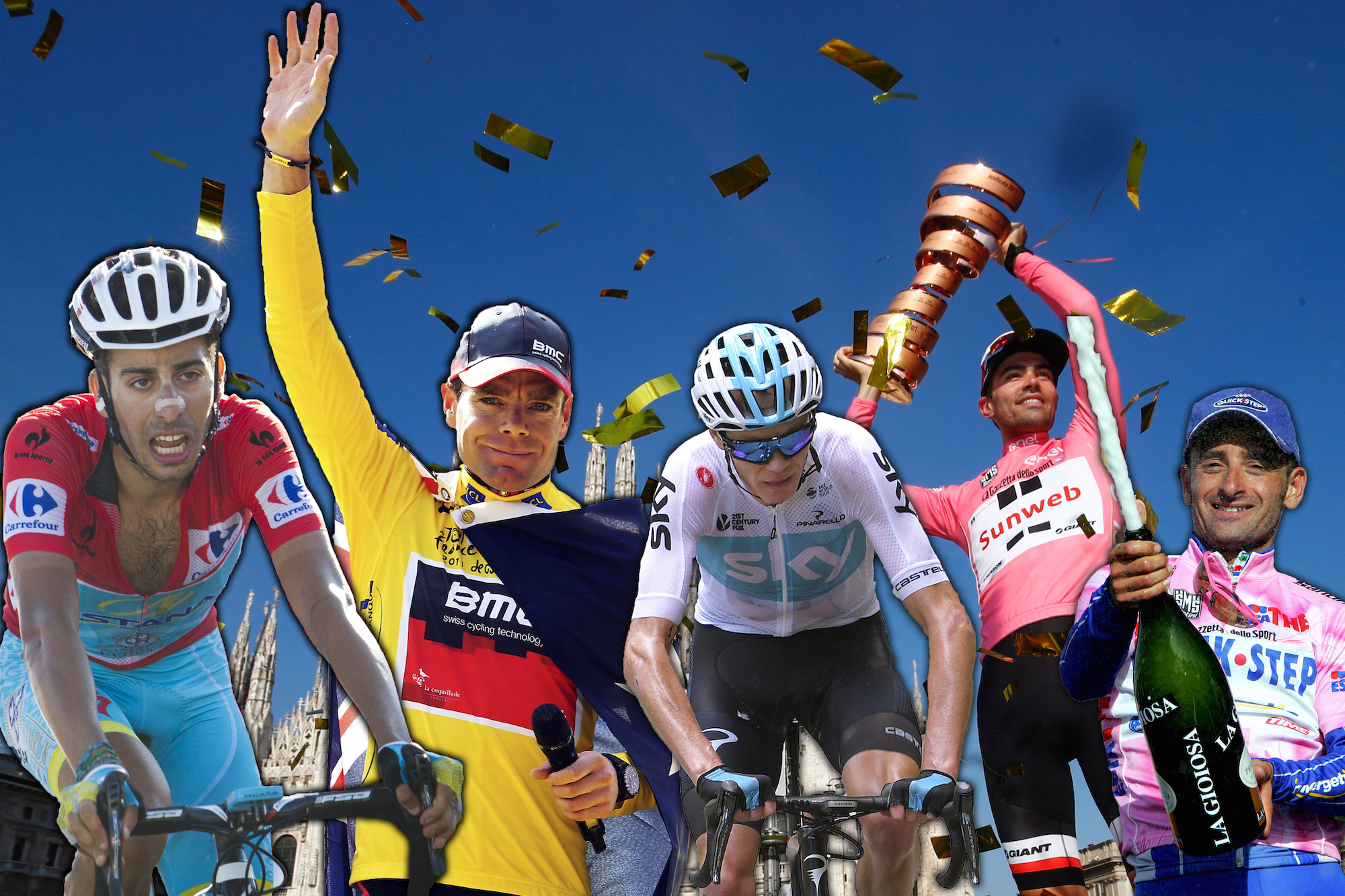
Images from Getty
If the Grand Tour hadn't existed in 2000, would someone have invented it?
The cost, the complexity of running it, the sheer size of the event all for what are often fleeting moments of high drama would make it likely they would not have.
The Grand Tour format is in many ways a throwback to another time when a day's worth of racing would only serve to be packaged down into several pages of newsprint, not shown live all day long. "Do the kids of today have the attention span for a three-week race?" the sport's commissioners would have asked.
As a fan, you have to invest in a Grand Tour. While there are always intriguing and entertaining plot lines in the opening days, the main event frequently doesn't crackle into life until the end of the first week at best - despite race organisers' attempts to force the issue higher up the peloton's agenda. In that respect, though, it parallels a more recent phenomenon - the DVD series boxset.
A good Grand Tour is binge-worthy sport delivered on a daily release schedule. The best ones are The Wire; should Contador have waited for Schleck when he dropped his chain is a question up there with whether McNulty would have ever caught Stringer Bell.
>>> Subscriptions deals for Cycling Weekly magazine
The worst, well we simply don't think about them, they're dull and procedural and all the characters do exactly what you expect them to. But we tune in next time because we know that it's good when riders are going toe-to-toe, and when they're doing things we couldn't possibly imagine it's transcendent. Something like that would always be worth inventing.
The latest race content, interviews, features, reviews and expert buying guides, direct to your inbox!
5. 2018 Giro d'Italia
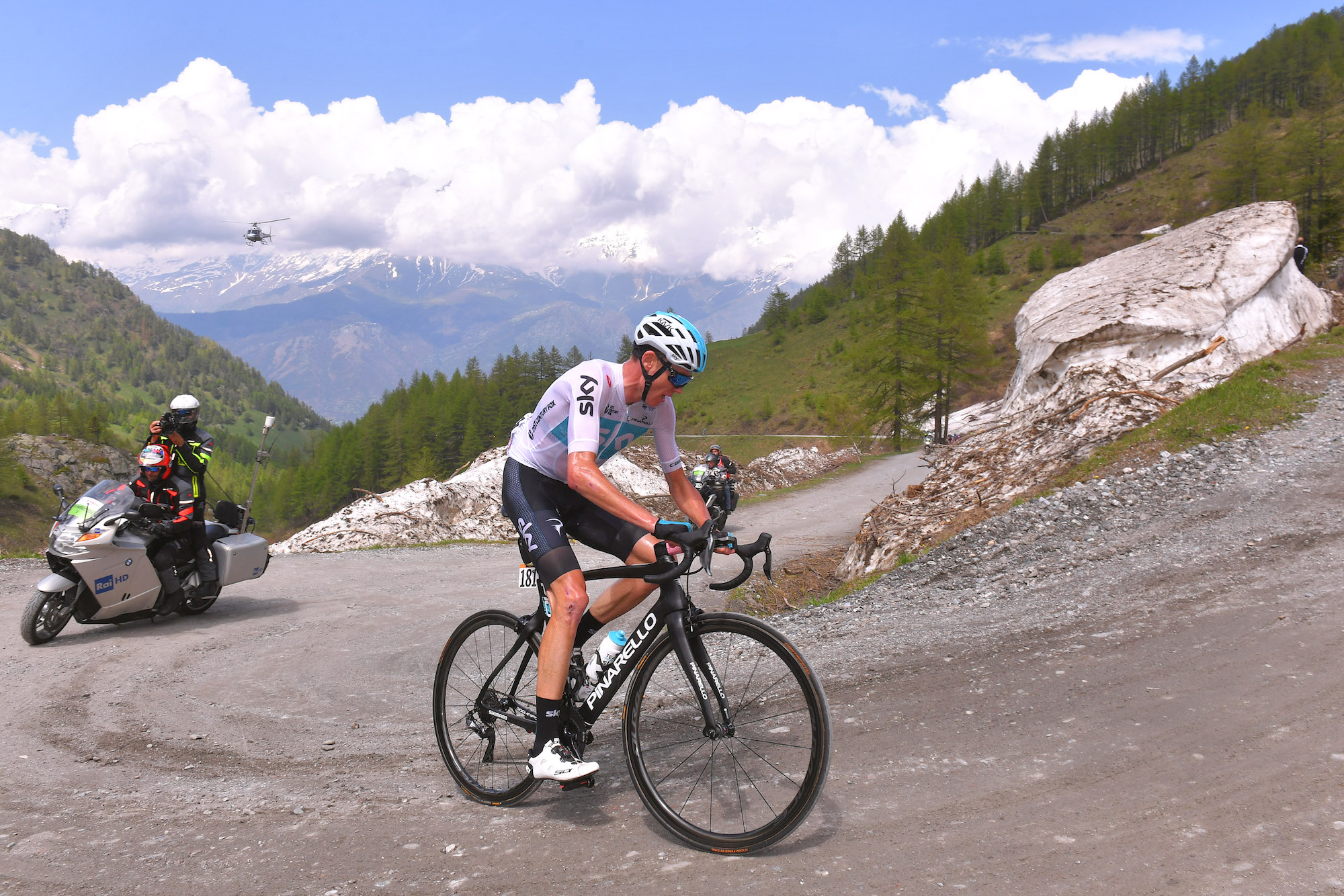
British riders have won 10 Grand Tours this century, and this was surely the pick of them. Simon Yates dominated the first three-quarters of it, taking the lead when he and Mitchelton team-mate Esteban Chaves finished ahead of the other favourites on Mount Etna. Winner of three stages over the following 10 days, Yates gradually extended his lead to more than two minutes and still held half of that advantage after the stage 16 Rovereto TT.
Two days later, though, the first cracks in the Lancastrian's armour appeared at Preto Nevoso. The next day, Yates and the rest of the field were swept away by a daring 80km attack by Chris Froome that started on the gravel slopes of the Finestre. The all-or-nothing escapade gave him a full set of Grand Tour titles.
Final general classification
1. Chris Froome (GBr) Sky, in 89-02-39
2. Tom Dumoulin (Ned) Sunweb, at 46 seconds
3. Miguel Ángel López (Col) Astana, at 4-57
4. 2005 Giro d'Italia
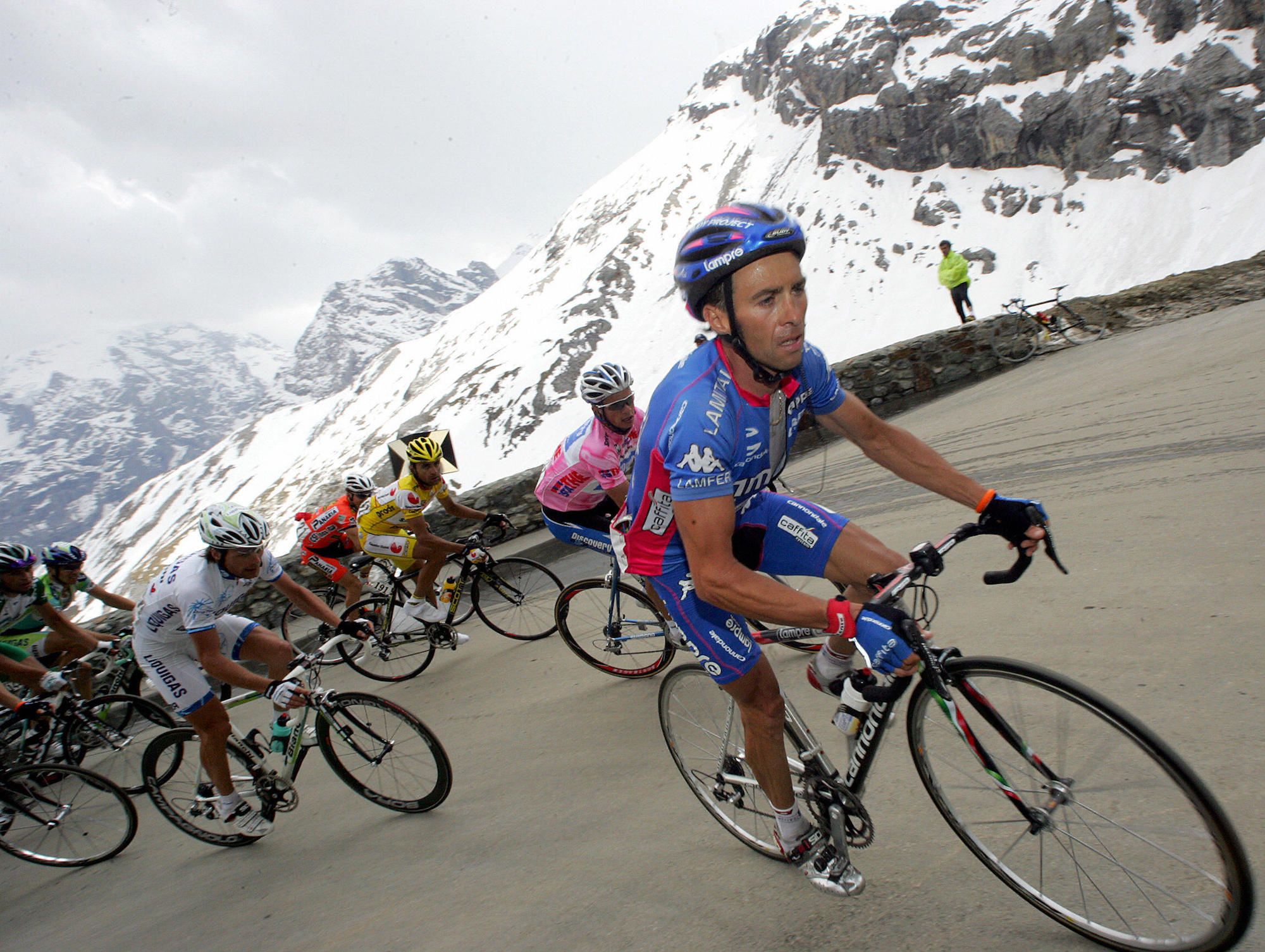
Another race that adds weight to the theory that Grand Tours are often more exciting when the big names struggle or are absent. This one was supposed to be a walk in the park for Ivan Basso, and when the Italian took the lead at the summit finish of Zoldo Alto on stage 11, becoming the eighth holder of the maglia rosa in the process, it looked like the GC had been locked up for good.
Basso, however, was hit by stomach trouble two days later at Ortisei, where Paolo Savoldelli inherited the pink jersey. Harassed by Danilo Di Luca, José Rujano and, above all, Gilberto Simoni, Savoldelli held on until the finish.
Nicknamed 'the Falcon' for his almost incomparable skill on descents, Savoldelli drew hugely on that ability to save the Giro title on the penultimate stage over the Finestre, dropping like a stone to wipe out the race-winning advantage Simoni had opened.
Final general classification
1. Paolo Savoldelli (Ita) Discovery Channel, in 91-25-51
2. Gilberto Simoni (Ita) Lampre-Caffita, at 28 seconds
3. José Rujano (Ven) Colombia-Selle Italia, at 45s
3. 2015 Vuelta a España
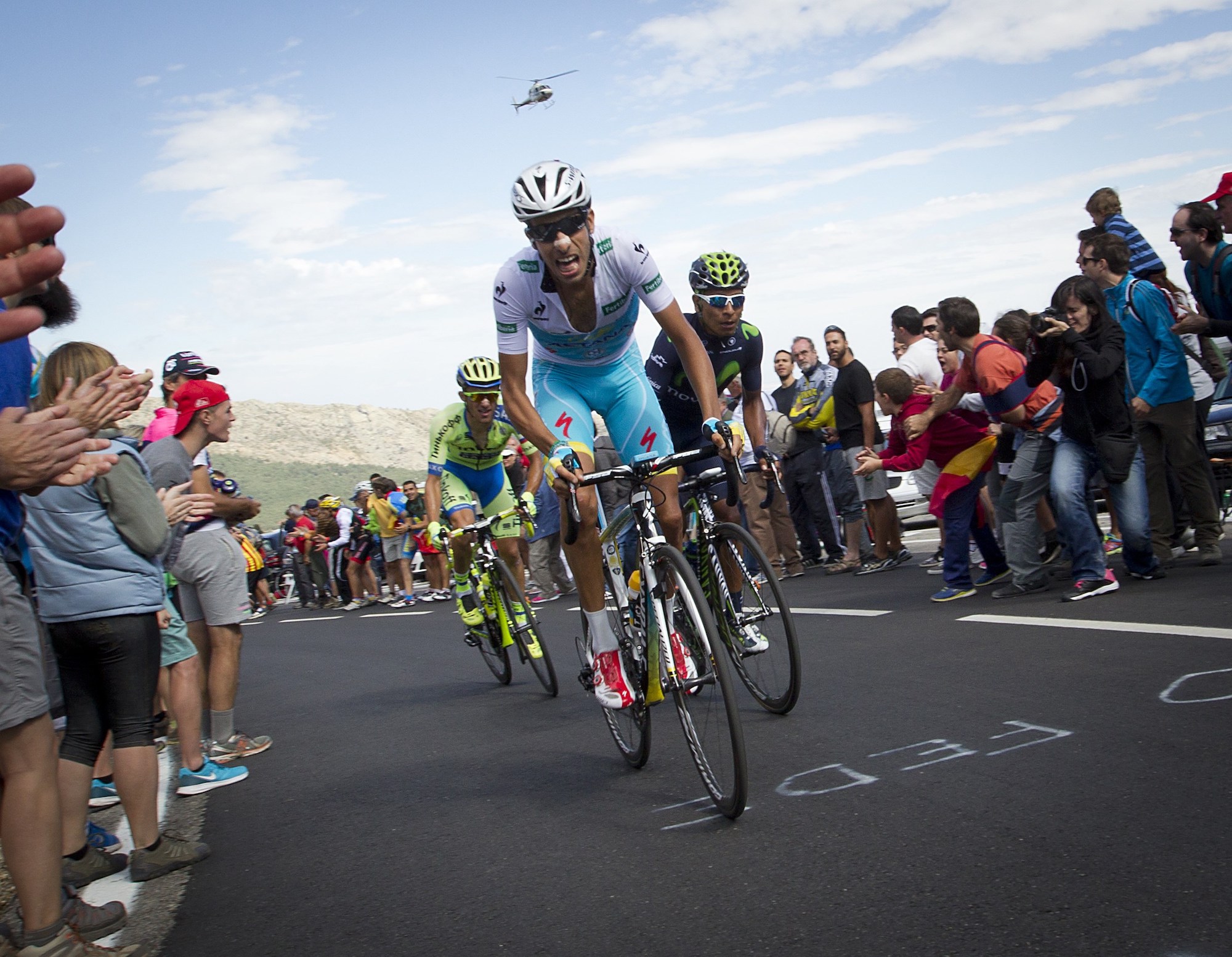
Another topsy-turvy affair, with Tom Dumoulin at the heart of the action that highlighted the tendency for the Vuelta to produce unpredictable contests at a point in the season when riders’ physical resources are running low. It featured the top-four finishers from the Tour de France five weeks earlier – Chris Froome, Nairo Quintana, Alejandro Valverde and Vincenzo Nibali – but this illustrious quartet all ended as bit-part players in a contest that revealed several new Grand Tour contenders, notably Dumoulin, Esteban Chaves and Fabio Aru.
Like all of the best three-week races, it also featured plenty of other intriguing and controversial back stories to keep interest bubbling, beginning on the first day when the short team time trial into Marbella had to be neutralised because the polished marble coastal path was covered in sand. On stage two, it was Nibali’s turn to appear in the spotlight for the wrong reasons. Delayed in a crash, he was caught on camera holding on to his team car’s door and being ferried at high speed back up to the bunch. That evening, the Italian was kicked off the race.
Chaves’s stage win that same day gave him the red jersey. He lost it to Dumoulin three days later when the bunch split coming into the finish, then regained it on the following stage thanks to a second hill-top finish success. The Dutchman snatched it back again three days later with a summit win of his own at the Cumbre del Sol, where Froome was a close second. Yet, just as the Briton’s form appeared to be peaking, he was forced out of the race after breaking his foot when he crashed into a kerb during a devilish six-climb tour of Andorra devised by local resident Joaquim Rodríguez. Here, Astana scooped the jackpot, Mikel Landa and Aru finishing first and second, the latter moving into the leader’s jersey.
>>> Cycling Weekly is available on your Smart phone, tablet and desktop
The see-saw contest continued across the Cantabrian mountains and into Asturias, where Dumoulin steadily ceded ground as Rodríguez emerged as Aru’s closest rival, moving within a second of the Italian thanks to a stage win at Sotres Cabrales on the third weekend, the Spaniard then moving a second ahead the next day. Would the Spanish veteran finally win a Grand Tour? Could he overcome his weakness in time trials? The long solo test delivered a resounding verdict – no! Dumoulin smashed it, Aru coped with it, leaving the Dutchman three seconds ahead. He doubled that advantage racing into Avila, two days from home.
Sadly for the Dutchman, there was one final twist, Aru and Astana shredding Giant-Alpecin’s defences around Dumoulin on the penultimate day on the heights to the north of Madrid. Isolated and attacked on all sides, he finally yielded, Aru riding away to claim his first Grand Tour success, a breathless contest finally decided.
Final general classification
1. Fabio Aru (Ita) Astana, in 85-36-13
2. Joaquim Rodríguez (Spa) Katusha, at 57 seconds
3. Rafał Majka (Pol) Tinkoff-Saxo, at 1-09
Points: Alejandro Valverde (Esp) Movistar
Mountains: Omar Fraile (Esp) Caja Rural
Teams: Movistar
2. 2017 Giro d'Italia
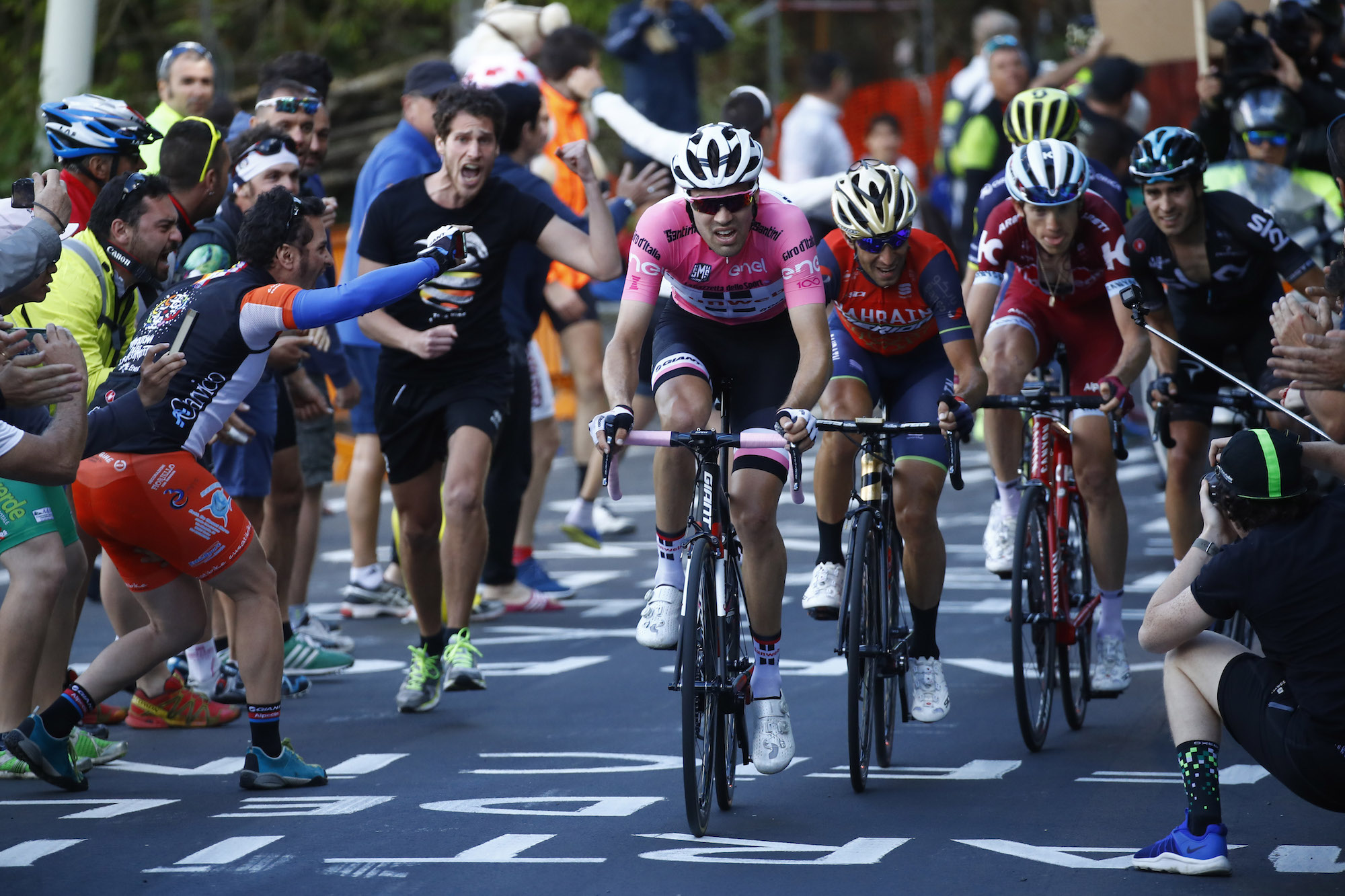
Having flirted with victory at the Vuelta a España in 2015, before faltering at the last and losing the title to Fabio Aru, Tom Dumoulin took his first Grand Tour win with a gritty and hugely courageous performance, coming through from fourth place to first in the Milan time trial on the final day to beat former winner Nairo Quintana and defending champion Vincenzo Nibali. Along with Thibaut Pinot, this quartet spent the second two weeks of the race constantly searching to deliver a knock-out blow to their rivals, the momentum swinging wildly between them, the spectacle entirely befitting the Giro’s 100th edition.
The race provided a perfect contrast of radically different racing styles, most obviously on the climbs. Strapping Dutchman Dumoulin was the archetypal rouleur grimpeur, trying to maintain a steady rhythm on the climbs, happy to lose ground to punchier rivals then steadily claw it back. At the other end of the scale was flyweight Colombian Quintana, far more spring-heeled, constantly darting away from his rivals, probing for a weakness, full of verve. Nibali and Pinot, meanwhile, were somewhere in between, both full of vim and tactically very smart.
The race began in Sardinia, where points winner Fernando Gaviria claimed the first of four stage wins (on stage three), but was supposed to come to life after a rest day transfer to Nibali’s Sicilian homeland. However, a strong headwind on the Mount Etna summit finish kept a lid on the action. The GC contest finally erupted on stage nine to the fearsome Blockhaus summit finish in the Abruzzo. It began with controversy as the group of main contenders had to swerve around a policeman’s bike. Wilco Kelderman clipped it, the subsequent domino effect leaving Sky’s Geraint Thomas and Mikel Landa on the deck, along with Orica’s Adam Yates, shattering the maglia rosa hopes of all three.
After Movistar had thinned out the lead group, dispatching race leader Bob Jungels in the process, Quintana fizzed into action. Initially countered by Nibali and Pinot, the Colombian went again, destined for the stage win and the pink jersey. It was Dumoulin, though, who emerged as best of the rest, judging his effort perfectly in order to limit his losses, Pinot clinging on to his wheel. Twenty-four hours later, the Dutchman struck back hard on his favoured terrain, demolishing the whole field in the Montefalco TT to take the lead with two and a half minutes on his rivals.
Impressive on the Blockhaus, Dumoulin was sensational at Santuario di Oropa. Apparently struggling when Quintana went on the rampage once more, the Dutchman worked his way back up to his rivals and then powered past them to win the stage and push his lead out a little further. The battle continued to rage the next day into Bergamo, where Jungels led in a very select dozen. Then came the biggest stage of the race, over the Mortirolo, Stelvio and Umbrail Pass into Bormio. It was always likely to be special, but we had absolutely no idea…
The peloton had been well shredded approaching the third of these mighty ascents, Dumoulin apparently well in control, until he braked to a sudden halt, flung off his kit and dropped into the ditch to relieve an urgent need.
For a while his rivals eased off, but when one attacked, the rest piled in. Out on his own, Dumoulin rode all out to protect the lead he’d built up. After Nibali’s descending skills, including bunny hopping obstacles, helped him to the stage win, Italy’s first of this 100th edition, Dumoulin came in more than two minutes down, his cushion now just 31 seconds.
Three major mountain stages remained, and each delivered an enthralling spectacle, fortunes yo-yoing this way and that, the favourites often so isolated from their team-mates that rivals would become allies for a few kilometres, then they’d be going at each other tooth and nail again. This was racing with the gloves well and truly off.
When Quintana swept the maglia rosa at Piancavallo two days from Milan, Dumoulin looked finished. But on the penultimate day over Monte Grappa to Asiago, he judged his effort and gave all he had to stay in the overall contest. On the final day, he unleashed everything he did have left and it was just enough.
Final general classification
1. Tom Dumoulin (Ned) Sunweb, in 90-34-54
2. Nairo Quintana (Col) Movistar, at 31 seconds
3. Vincenzo Nibali (Ita) Bahrain-Merida, at 40s
Points: Fernando Gaviria (Col) Quick Step
Mountains: Mikel Landa (Esp) Sky
Teams: Movistar
Best young rider: Bob Jungels (Lux) Quick-Step
1. 2011 Tour de France
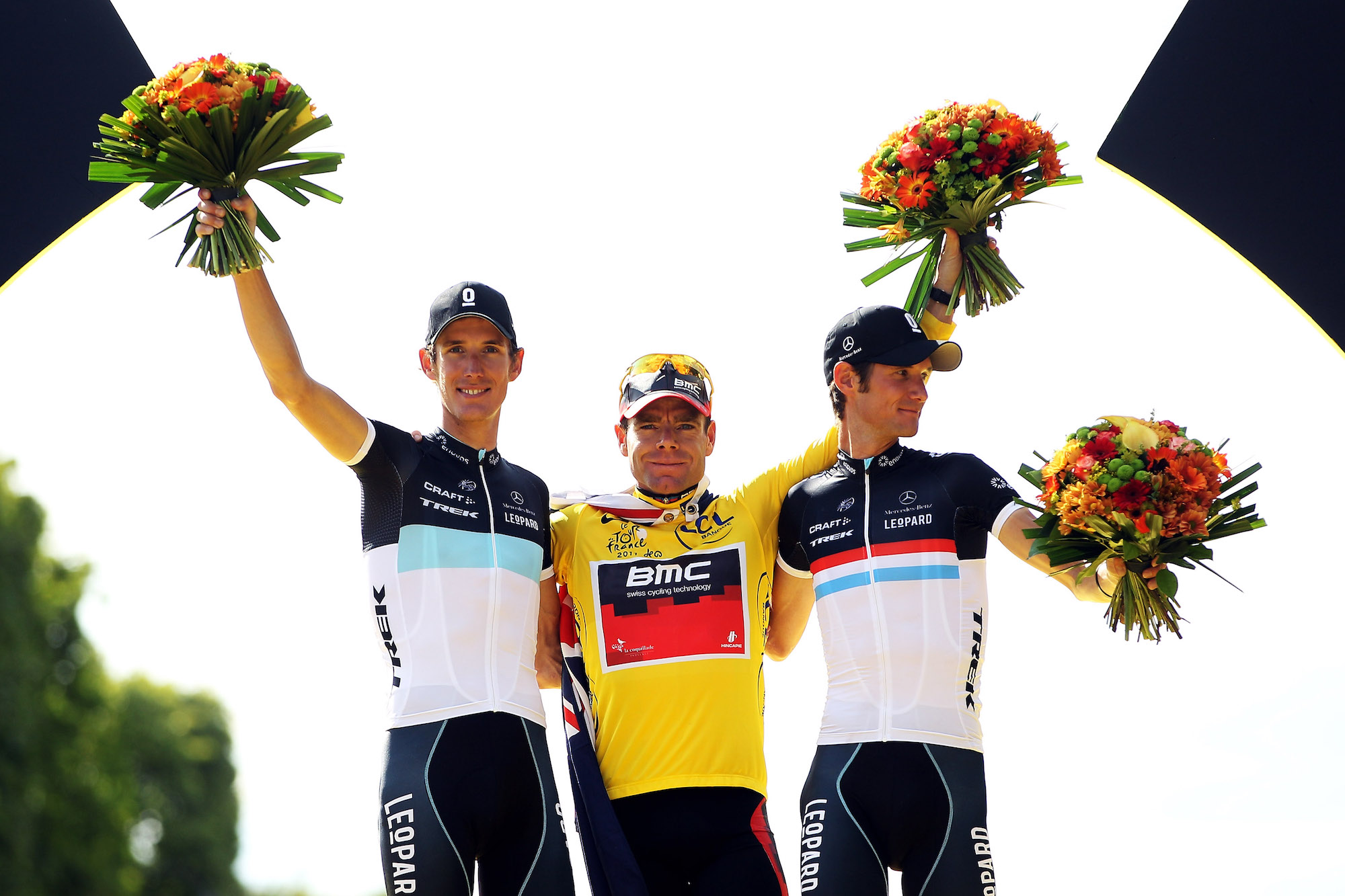
Often the best Grand Tours occur in between moments of dominance by a pre-eminent rider. Think of the 1987 Tour de France, when defending champion Greg LeMond was sidelined and the lead changed hands nine times, Stephen Roche ultimately claiming the yellow jersey on the penultimate day. Or of the 1956 race, which fell in between the last of Louison Bobet’s three consecutive wins and the first of Jacques Anquetil’s five victories, the lead changing hands eight times before the unheralded Roger Walkowiak took the title. In both of these cases, these riders emerged triumphant thanks as much to their astute tactical thinking as to their talent and endurance.
Among the five dozen races in the current century, the 2011 Tour went closer than any other to being a ‘Tour à la Walko’, of being a race where an outsider showed the nous and guts to upset the big guns and almost pull off the most unlikely of victories. The fact that this dark horse, Thomas Voeckler, was French also made this race stand out. What’s more, like the 1956 and 1987 Tours, the racing was often outstanding and unpredictable, with talking points aplenty. The context for the race increased the likelihood of it deviating from the standard script for Grand Tours. 2010 Tour winner Alberto Contador was under a cloud, awaiting the result of an appeal having tested positive in taking that title.
While he was waiting for the Court of Arbitration for Sport to reach its verdict, the Spaniard had raced and won the Giro d’Italia, a challenge that had sapped his resources. This edition was also the last before Sky imposed its authority on the Tour.
The 2011 Tour route highlighted race director Christian Prudhomme’s desire to bring the overall contenders out of the shadows as often as possible. The short but steep finish at Mont des Alouettes on the opening stage saw Philippe Gilbert blast away from the pack to take victory, with Cadel Evans, one of the favourites for the title, the Belgian’s closest challenger, although the impressiveness of the Australian’s performance was largely overlooked by the first significant incident, a late crash costing Contador more than a minute. Three days later, though, Evans took all of the headlines as he out-thought and out-raced Contador at Mûr-de-Bretagne to win the stage.
As Garmin-Cervélo’s Thor Hushovd defended a one-second lead over Evans, attention switched to the sprinters. Mark Cavendish won at Cap Fréhel, the next day Edvald Boasson Hagen gave Sky their first Tour stage win at Lisieux. Cavendish won again at Châteauroux, where Sky’s very promising first week came apart. A high-speed crash in the bunch with 40km remaining, left a number of riders on the deck, sixth-placed Bradley Wiggins among them. A broken collarbone ended his race before the first week was over.
This Tour’s elevation from good to gripping began on stage nine to Saint-Flour, where Hushovd’s seven-day spell in yellow ended. The route took the riders through the heart of the Massif Central, crossing eight categorised climbs. Descending off the second of them, the Pas de Peyrol, another big crash in the bunch saw two more favourites abandon, Alexandre Vinokourov and Jurgen Van den Broeck. As the peloton eased up, the five riders in the break up ahead – Voeckler, Johnny Hoogerland, Luis León Sánchez, Juan Antonio Flecha and Sandy Casar – pushed their advantage out to almost eight minutes, presenting Voeckler with the chance of the yellow jersey.
In a day packed with incident, the most striking of all occurred when a France Télévisions car attempted to overtake the break, skidded in the grass verge and swerved towards the riders, clipping Flecha, who collided with Hoogerland, the Dutchman and his bike cartwheeling off the road and into a barbed wire fence. Although both riders were able to continue, Hoogerland’s multiple lacerations later required 33 stitches. At the finish, Sánchez breezed to the stage win, Voeckler took the lead, his advantage 2-26 on Evans, with the Schleck brothers just seconds behind the Australian.
After a third win for Cavendish, the race reached the Pyrenees. Just as he had in 2004 when he’d led the race for 10 days, Voeckler began to draw on the magical force of the yellow jersey. At Luz Ardiden, he lost 30 seconds to Evans and 40 to Fränk Schleck, who moved into second. Crossing the Aubisque on the subsequent stage into Lourdes, he lost nothing. Much more remarkably, on a six-climb stage through the Pyrénées Ariégeoises to Plateau de Beille, he was as strong as his rivals. Urged on by French fans, feeding off their enthusiasm, Voeckler began to make the almost impossible look slightly feasible.
Another win for Cavendish in his pomp was followed by a wet stage into Gap, where Voeckler’s daring on the sodden descent off the Col de Manse saw him gain time on the Schlecks. It presaged four days of the kind of wonderful racing that is rarely seen in the second half of any Grand Tour’s third week. On the first, to Pinerolo in Italy, Voeckler, pressing too hard, went off the road twice on the final descent, 27 seconds of his lead chipped away.
Then came the stage to the Galibier, the Tour’s highest-ever summit finish. Overnight, the Schlecks and their Leopard-Trek team-mates cooked up a daring plan, then set about enacting it. It began with Joost Posthuma and Maxime Monfort finding their way into the break on the long climb back into France via the Col Agnel. Approaching the highest sections of the second climb, the Col d’Izoard, Schleck junior took off on his own and bridged across to them. Although Posthuma soon fell back as they started towards the Col du Lautaret, Monfort lasted longer, before Andy Schleck pressed on solo. With Eddy Merckx an enthralled spectator in Prudhomme’s lead car, his ride was like something from another era, when long-range attacks that overturned the standings were not uncommon.
Andy Schleck’s lead over his rivals was four and a half minutes with 10km to go. At this point, sensing his Tour hopes were fast disappearing, the diesel-like Evans engaged his turbo. With barely any help from the other contenders, the Australian powered after Andy Schleck in what became the most extraordinary of pursuit matches. Evans’s barnstorming chase meant that Voeckler, who’d doggedly stuck to the Australian’s wheel, kept his lead by 15 seconds over Andy Schleck.
If that was sensational, the next day to Alpe d’Huez was almost as good. It was just 109.5km long, and Contador attacked almost as soon as the first climb, the Col du Télégraphe, began, Andy Schleck, Voeckler and Evans chasing after him. The Australian soon dropped back to find his team-mates. However, as Contador and Andy Schleck accelerated again, Voeckler found himself in no-man’s land. Rather than following the Australian’s example, he persisted with his chase, his long hold on yellow leading him to overestimate his own ability.
This uncharacteristic tactical misjudgement not only cost him the lead, but a place on the podium, as Andy Schleck moved into yellow, 53 seconds up on brother Fränk and 57 ahead of Evans. It didn’t look enough of an advantage to fend off the Australian in the undulating time trial at Grenoble on the penultimate day, and it wasn’t. Evans was two and a half minutes quicker and took the lead for the first and the most critical time. As Cavendish clinched a fifth stage win and the points title in Paris, Evans received the ultimate prize for his persistence, a very worthy winner of a wonderful race.
Final general classification
1. Cadel Evans (Aus) BMC, in 86-12-22
2. Andy Schleck (Lux) Leopard Trek, at 1-34
3. Frank Schleck (Lux) Leopard Trek, at 2-30
Points: Mark Cavendish (GBr) HTC-Highroad
Mountains: Samuel Sánchez (Esp) Euskaltel
Team: Garmin-Cervélo
Best young rider: Pierre Rolland (Fra) Europcar
The full version of this featured ranked all 60 Grand Tours of the century so far and originally appeared in the print edition of Cycling Weekly. Subscribe now to never miss an issue or find it on sale in newsagents and supermarkets, priced £3.25.
Peter Cossins has been writing about professional cycling since 1993, with his reporting appearing in numerous publications and websites including Cycling Weekly, Cycle Sport and Procycling - which he edited from 2006 to 2009. Peter is the author of several books on cycling - The Monuments, his history of cycling's five greatest one-day Classic races, was published in 2014, followed in 2015 by Alpe d’Huez, an appraisal of cycling’s greatest climb. Yellow Jersey - his celebration of the iconic Tour de France winner's jersey won the 2020 Telegraph Sports Book Awards Cycling Book of the Year Award.